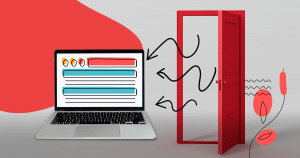You already know that tracking results is essential to the success of any service or product.
When it comes to SaaS companies, this measurement is even more vital.
After all, business sustainability in this segment is directly linked to customer retention, which depends on customer satisfaction.
That said, there is no point in observing and interpreting sales metrics without considering their relevance to your operations.
This means that, in any business, there are data that can generate valuable insights and others with empty meaning. The latter are called vanity metrics.
So, which growth metrics for SaaS should you really devote your attention to?
To answer that question, we’ve put together this article. In it, we will delve into these 10 metrics:
- 1. Lead velocity rate (LVR)
- 2. Lead Conversion Rate (LCR)
- 3. Monthly Recurring Revenue (MRR)
- 4. Churn Rate
- 5. Average Revenue per User (ARPU)
- 6. Lifetime Value (LTV)
- 7. Customer Acquisition Cost (CAC)
- 8. Quick Ratio
- 9. Expansion Revenue
- 10. Net Promoter Score (NPS)
- Sales Metrics Tools and Monthly Active Users (MAU)
- Wrap Up: SaaS Sales Metrics for Informed Decision-Making
Keep reading!
1. Lead velocity rate (LVR)
Qualified lead generation is one of the most meaningful activities for business success.
By dealing with prospects at an advanced stage of the buyer’s journey, you maximize the chances of conversion and avoid wasting time addressing people who have no interest in your solution.
In this sense, it is vital to work on strategies to accelerate the generation of qualified leads.
Lead Velocity Rate (LVR) is the metric used to monitor this progress. The idea is to measure the growth of qualified lead generation in a month and compare it to a previous period.
If measured monthly, LVR can generate accurate insights regarding the growth of the business in terms of revenue and customer acquisition.
It is, therefore, an efficient mechanism for real-time monitoring of the sales team’s performance.
To calculate the Lead Velocity Rate, follow these steps:
- find the difference between the leads generated in the current month and the previous month;
- divide the value by the number of leads generated in the current month;
- multiply the result by 100.
2. Lead Conversion Rate (LCR)
As important as the volume of leads generated is the efficiency in their conversion.
A converted lead is the one that goes through the entire consumer journey and makes the buying decision. In other words, it is simply the prospect that becomes a customer.
The Lead Conversion Rate is a regular element in salespeople’s evaluations and analyses regarding the effectiveness of the employed strategy.
Regardless of the number of leads handed to the sales team, its objective is always to convert the largest quantity possible.
For the Lead Conversion Rate to be used with excellence, management must understand the company’s internal and external factors.
This way, it is possible to determine, without guesswork, if the rate is satisfactory or if it is necessary to take action for its optimization.
For example, a company that adopts a freemium model — a free service that monetizes through premium subscriptions — may have a lower LCR than one that offers a free trial.
However, this does not mean that one cannot invest in strategies to increase the number of premium subscribers.
To calculate the Lead Conversion Rate, follow these steps:
- find out the number of new customers in a period;
- find out the number of leads generated in the same period;
- divide the first figure by the second;
- multiply the result by 100.
3. Monthly Recurring Revenue (MRR)
Most SaaS companies operate under a model where revenue is generated mainly through subscriptions.
If customers are satisfied, they renew their subscriptions and keep the enterprise’s monthly revenue stable. Thus, recurring revenue is generated.
The Monthly Recurring Revenue metric measures the amount received each month from these subscription renewals.
It is crucial to understand that this is different from net revenue, representing the amount that is actually received in the month.
To understand, imagine that a given period shows a significant growth in new subscriptions. The profit generated by these sales is certainly included in the net revenue calculation but not in Monthly Recurring Revenue.
To calculate MRR, simply follow the following formula:
MRR = number of customers x average amount paid by them.
If you want to calculate the annual recurring revenue, simply multiply the value found with the formula above by twelve.
4. Churn Rate
Among the growth metrics for SaaS, the Churn Rate draws attention because it calculates a downward movement.
The goal is to understand the number of customers or subscribers lost in a given period. Such an understanding is essential for short and medium-term business planning.
Of course, it is impossible to retain all customers. Eventually, some will stop using the service for numerous different reasons.
With this in mind, many managers believe that simply replacing the lost subscribers is enough to maintain the business sustainability.
The problem is that a high Churn Rate is just the tip of the iceberg. After all, if people are stopping using a service, it fails to deliver what the audience expects.
This generates negative feedback from users, which creates an obstacle in the acquisition of new consumers.
To calculate the Churn Rate, follow the steps below:
- find out the number of customers lost in a period;
- divide the value by the number of existing customers at the beginning of the same period;
- multiply the result by 100.
5. Average Revenue per User (ARPU)
Average Revenue per User is a crucial sales metric, especially for startups looking to scale their business.
Understanding the value generated to the company by each active customer allows management to strategically calculate the investment in issues such as user support and service.
If the ARPU is too low, a simple support call may generate a higher cost than the profit generated by the customer.
Thus, Average Revenues Per User is also essential in pricing the service. The value must be higher than the average cost of retention per customer, or the sustainability of the business will not hold for much longer.
In addition to strategic planning, this indicator optimizes your understanding of consumer preferences.
If the most expensive plans on your service have a higher uptake, for example, this will translate into maximization of the average revenue per user.
To calculate ARPU, simply divide the Monthly Recurring Revenue by the number of active customers.
6. Lifetime Value (LTV)
If you are looking for longer-term customer relationships, this metric is invaluable.
Lifetime Value (LTV) deals with the expected amount a customer will spend on your product throughout the relationship. Hence the name “Lifetime”.
By calculating the LTV, it is possible to elaborate a smarter budget tied to the company’s real situation.
After all, if you know the revenue generated by just one consumer, you can decide how much you are willing to spend on their acquisition and retention, always standing above the line between expenses and revenue.
That’s why the Lifetime Value calculation must be accompanied by another metric, which predicts the acquisition cost per customer.
We will talk about this in the next topic. First, let’s understand how the LTV calculation is performed:
- calculate the Churn Rate;
- calculate the Average Revenue per User;
- divide the second value by the first.
7. Customer Acquisition Cost (CAC)
While reading the last topic, you already knew how important it is to understand the Customer Acquisition Cost.
This indicator measures the amount of money that your company needs to invest in order to convince a consumer to purchase.
Since every business needs to make more money than it spends to survive, the value indicated by this metric must be lower than the LTV.
Therefore, the use of CAC determines exactly what the maximum you can spend is when prospecting new customers.
You must take all kinds of investments in this regard into account, both those related to marketing and those linked to sales.
So the CAC calculation is structured in a very simple way. Just add up all the costs directed to the marketing and sales departments, and then divide the figure obtained by the number of new customers acquired.
8. Quick Ratio
Given the Churn Rate, how confident can a SaaS company be regarding increasing its own revenue?
The answer to this question is obtained by calculating the Quick Ratio. The metric is used to measure and indicate the efficiency of business growth.
To perform the calculation, you need to have data related to the MRR, which is the Monthly Recurring Revenue of your business. Then, simply divide the amount related to new MRR sources by the percentage of MRR lost in the same period.
9. Expansion Revenue
Expansion Revenue is an essential indicator for any company looking to raise revenue generated by existing customers.
Since SaaS companies usually work with plans that can be upgraded, Expansion Revenue is crucial.
A customer can, for example, start using the service with a basic plan, which is naturally cheaper than premium options. This way, it is already included in your Monthly Recurring Revenue calculation. However, the option to upgrade opens an interesting path for the company.
By opting for a more advanced plan, the customer increases the revenue they generate for the business.
Therefore, many companies focus on stimulating this upgrade as a way to compensate for the loss of other customers.
To calculate the Expansion Revenue, just add up the additional value generated by subscription upgrades.
10. Net Promoter Score (NPS)
Customer loss is a problem faced by every type of company, regardless of its size or segment.
To avoid it becoming too big of an issue, you need to identify as early as possible the reasons that are driving customers to abandon your service.
With this in mind, it is easy to understand the importance of frequently measuring your customers’ satisfaction, right?
This is what the Net Promoter Score seeks to do. Unlike the other indicators presented in this text, NPS is not based exclusively on mathematical calculations.
It is a methodology released to the world in 2003 through an article published in the Harvard Business Review. Based on a simple and definitive question, the idea is to understand the level of contentment among consumers of any product or service.
The question is, “On a scale of 0 to 10, how much would you recommend company X to a friend or colleague?”
By gathering a significant number of responses, it is possible to separate customers into three groups.
- Those who answered between 0 and 6 are considered detractors. They are dissatisfied with the solution.
- Those who chose a number between 7 and 8 are called neutral. They consider the service satisfactory but do not go beyond this.
- Those who score 9 or 10 are called promoters and are absolutely loyal customers.
From these insights, it is possible to design and execute a strategy to rescue the detractors, encourage the neutrals, and maintain the promoters’ positive user experience.
Sales metrics for SaaS are tools that enable intelligent, numbers-based management.
In this way, managers find it easier to make decisions that are, in fact, efficient for the healthy development of the company.
Sales Metrics Tools and Monthly Active Users (MAU)
In addition to these key metrics, tracking tools play a crucial role. Consider using software like Salesforce, Freshworks, and HubSpot to streamline the process of collecting and analyzing data. These tools offer comprehensive features, from lead management to sales forecasting, providing a holistic approach to SaaS sales metrics.
Wrap Up: SaaS Sales Metrics for Informed Decision-Making
By incorporating these metrics and utilizing effective tracking tools, your company gains invaluable insights. Whether it’s customer acquisition, retention, or revenue growth, these metrics provide a roadmap for informed decision-making.
Before you leave, here’s a crucial step to supercharge your SaaS strategy: Elevate your content game with WriterAccess. Our platform connects you with top-notch writers, editors, and designers to create content that not only ranks high but engages and converts. Quality content is the bedrock of a well-ranked blog and successful SaaS strategy.
Ready to unlock the power of premium content? Explore WriterAccess today!










